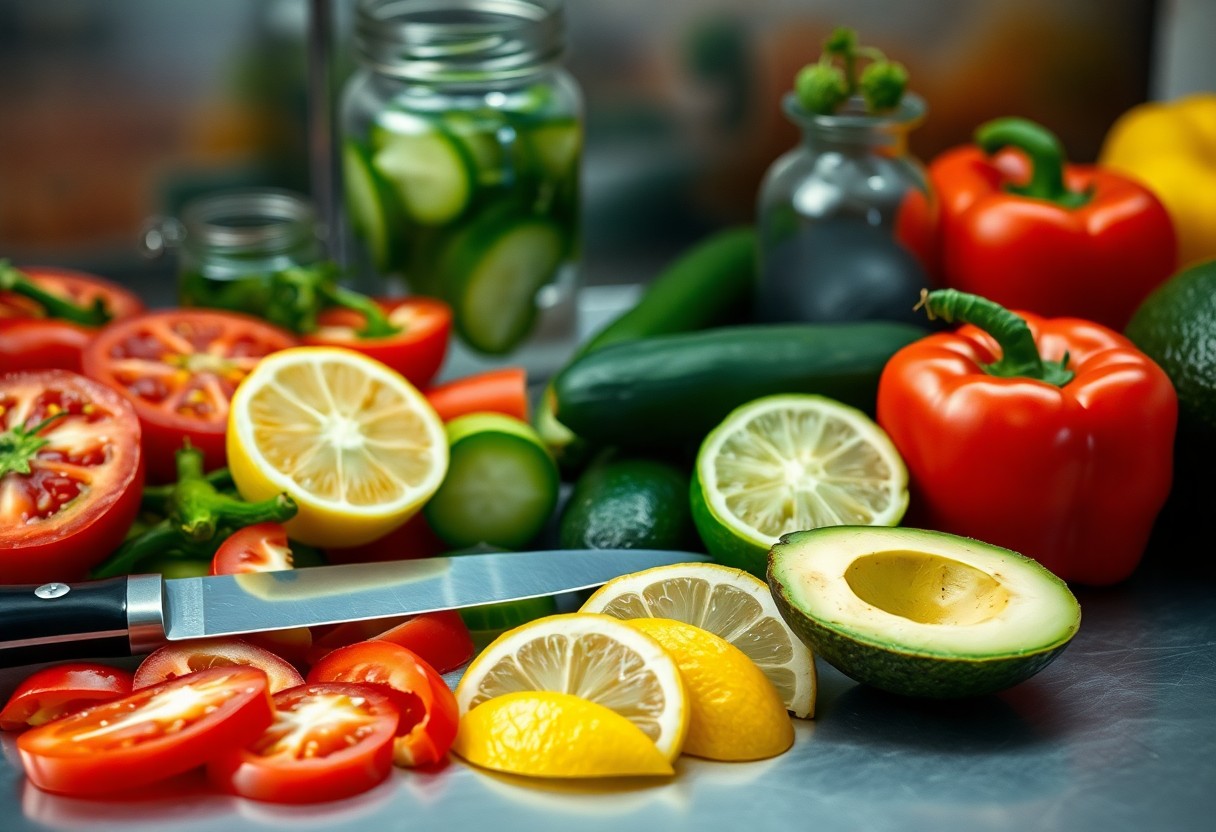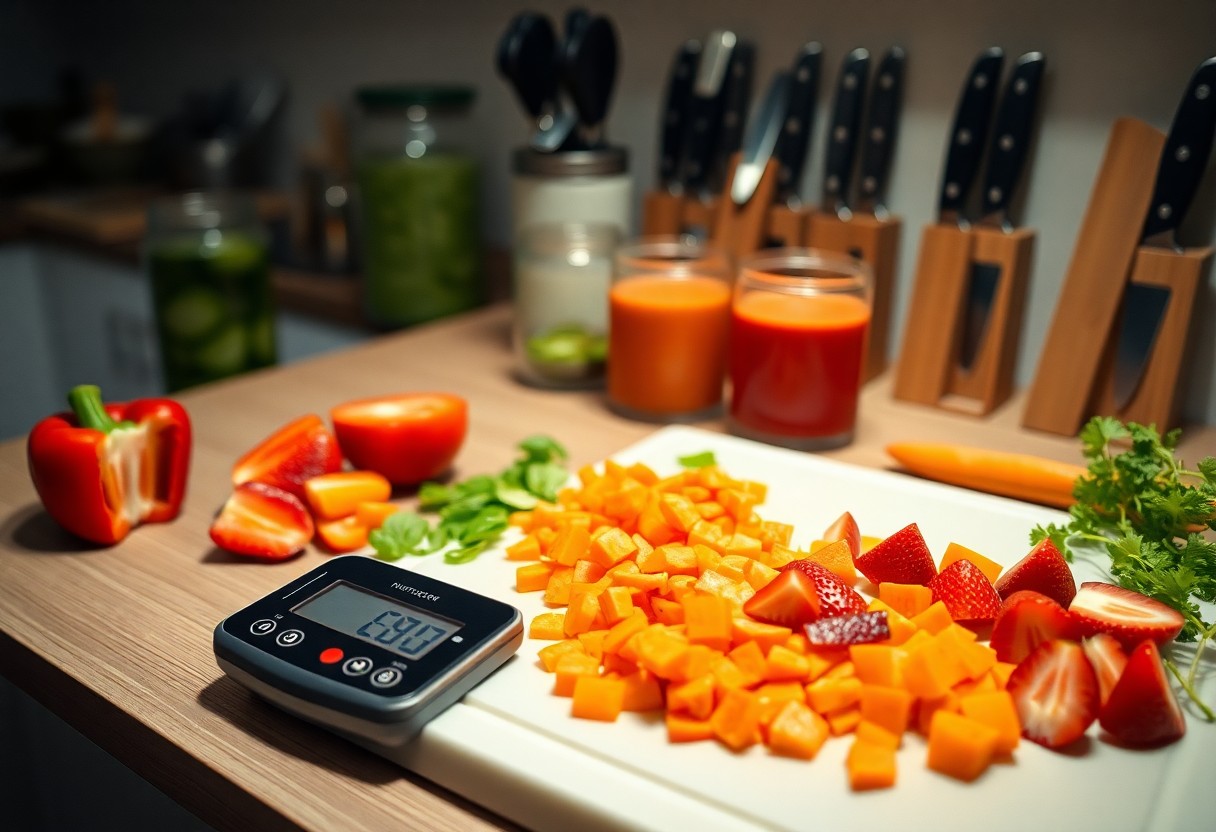Over time, the way you cut your fruits and vegetables can significantly impact their nutritional value. Using proper cutting techniques helps retain crucial vitamins while preventing oxidation and nutrient loss. Ensure you use sharp knives to minimize cell damage and cut items just before consumption for maximum freshness. Additionally, check out 5 Ways to Make Cut Fruits and Vegetables Last Longer to enhance your meal prep habits.

Key Takeaways:
- Minimize exposure to air and light by cutting fruits and vegetables right before consumption.
- Use sharper knives to make cleaner cuts, which can help preserve cell structure and nutrients.
- Consider cutting into larger pieces, as smaller pieces increase surface area and nutrient loss.

Understanding Nutrient Preservation
Preserving the nutrients in fruits and vegetables hinges on understanding how different cutting methods affect their health benefits. By recognizing the delicate balance between exposure to oxygen, light, and moisture, you can make informed choices that enhance your meals while retaining vital vitamins and minerals. Techniques that minimize cell damage during cutting contribute to maintaining a higher concentration of important nutrients in your diet.
Importance of Nutrients in Fruits and Vegetables
Nutrients such as vitamins, minerals, and antioxidants found in fruits and vegetables play a pivotal role in overall health. They support immune function, reduce inflammation, and promote proper digestion. Regular consumption of these nutrient-dense foods can lower the risk of chronic diseases, making them important for a well-balanced diet.
Factors Affecting Nutrient Loss
Several factors influence the extent of nutrient loss in cut fruits and vegetables. These include exposure to air, temperature fluctuations, and prolonged storage time. The enzymatic reactions triggered by cutting can lead to degradation, particularly of sensitive vitamins like C and B. Additionally, the method of cutting-such as size and surface area-affects how quickly nutrients might diminish. Any delay in consumption can exacerbate these effects.
- Exposure to air accelerates oxidation.
- Temperature can impact vitamin stability.
- Cutting method changes nutrient availability.
- Storage time significantly influences nutrient retention.
- Any improper handling may lead to nutrient degradation.
Delve deeper into factors affecting nutrient loss to understand how you can further safeguard their integrity. Cooking methods such as boiling or frying can rapidly deplete vitamins, while cutting fruits and vegetables into smaller pieces increases their surface area, thus heightening exposure to air and moisture. Light can similarly degrade certain compounds, making it important to store produce in low-light conditions. Regularly assessing these factors will help you make optimal decisions that maintain the nutritious profile of your meals.
- Cooking methods can cause vitamin depletion.
- Surface area increase leads to faster nutrient loss.
- Storage conditions play a critical role.
- Light exposure can degrade nutrients.
- Any oversight in handling can diminish benefits.
How to Cut Fruits and Vegetables
The method you choose for cutting fruits and vegetables can greatly influence nutrient retention. Aim for techniques that create fewer surface areas exposed to air and light, as these conditions can lead to nutrient degradation. You might consider slicing, dicing, or julienning, depending on the intended use, while keeping pieces larger when possible. For delicate foods, experiment with more gentle methods to avoid bruising and loss of nutrients.
Recommended Cutting Techniques
Utilize sharp knives, as they produce cleaner cuts, minimizing cellular damage and nutrient leakage. Techniques such as mincing or shredding might be effective for flavor release but can also increase the risk of nutrient loss. Try to slice fruits and vegetables just before consumption or cooking, especially for items like avocados and bananas, which oxidize quickly.
Timing: When to Cut for Freshness
Cutting fruits and vegetables right before eating or cooking maximizes freshness and nutrient preservation. Once cut, produce begins to lose vitamins, especially water-soluble ones like vitamin C. The longer they are exposed to air, the more nutrients degrade, impacting both taste and health benefits. For example, a cut apple can start losing its vitamin C content significantly within hours.
In practical terms, consider purchasing whole fruits and vegetables whenever possible. This strategy allows you to cut them just prior to use, ensuring maximum freshness and reducing oxidative damage. If you must cut in advance, store cut items in an airtight container and refrigerate them, which can help minimize nutrient loss. Techniques such as briefly blanching vegetables before freezing can also preserve nutrients if you plan on cutting and storing them for later use.
Tips for Maximizing Nutrient Retention
To ensure the highest nutrient retention in your fruits and vegetables, be mindful of your cutting methods and timing. Use sharp knives to make clean cuts that minimize cell damage and oxidation. Cut just before consumption to avoid prolonged exposure to air, which degrades vitamins. Integrate techniques like steaming instead of boiling and try to keep skins on where appropriate to retain fiber and nutrients.
- Utilize sharp knives for clean cuts.
- Cut just before eating to reduce nutrient loss.
- Explore steaming methods instead of boiling.
- Preserve skins when possible for added nutrients.
Any effort to implement these tips will help you maximize the nutritional benefits of your produce.
Tools and Equipment Suggestions
Investing in high-quality kitchen tools can greatly enhance your food preparation experience and nutrient preservation. Opt for ceramic knives to reduce browning and oxidation, and use a mandoline slicer for uniform cuts that ensure even cooking. Consider a steamer basket for healthy cooking methods that retain vitamins. These tools not only make your cutting tasks efficient but also contribute to the overall nutrient quality of your meals.
Best Practices for Storage
Proper storage techniques are imperative for maintaining the freshness and nutritional integrity of your fruits and vegetables. Keep them in a cool, dark place or refrigerate when needed, as light and heat can accelerate nutrient degradation. Use breathable bags or containers, which help control humidity and prevent mould growth, while retaining imperative vitamins and minerals. Check produce regularly and remove any spoiled items to prevent the spread of decay.
Expanding on storage practices, consider investing in transparent containers to easily monitor food quality without constant opening. Store leafy greens in damp paper towels within sealed bags to maintain moisture without causing rot. Apples can emit ethylene gas, so keep them separate from other fruits to prolong their freshness. Any meticulous approach to storage will significantly enhance the longevity and health benefits of your fruits and vegetables.
Common Mistakes to Avoid
Avoiding common mistakes can greatly enhance your fruit and vegetable preparation, ensuring maximum nutrient retention. One prevalent error is failing to manage exposure to air and light, which can degrade vitamins. You should also be cautious about the knife techniques you employ, as improper cuts can lead to nutrient loss and compromised texture. Staying mindful of these factors is key to maintaining the health benefits of your food.
Over-Exposure to Air and Light
When you allow fruits and vegetables to be overly exposed to air and light, oxidation occurs, leading to the loss of valuable nutrients, particularly vitamin C, and other antioxidants. Minimize this exposure by cutting only what you need and covering portions you are not using immediately to shield them from environmental elements.
Using Incorrect Knife Techniques
Incorrect knife techniques not only make food preparation inefficient but can also affect nutrient preservation. For instance, using a dull knife can crush delicate produce, causing cell damage and nutrient leakage. Aim for clean, swift cuts with a sharp knife to keep more nutrients sealed within the fruits and vegetables. Additionally, employing the right cutting techniques, such as chopping or slicing rather than mashing, can help retain their structure and nutritional integrity.
Special Considerations for Specific Fruits and Vegetables
When preparing certain fruits and vegetables, unique approaches can effectively preserve their nutrient content. Each variety might require specific handling techniques to maintain optimal health benefits. Understanding these distinctions allows you to enjoy the maximum flavor and nutrition of your produce.
Leafy Greens
For leafy greens, such as spinach and kale, it’s best to tear them instead of cutting with a knife. This minimizes oxidation and nutrient loss, particularly for vitamins A, C, and K. Keep them whole until just before consumption to extend freshness and retain their nutrient integrity.
Root Vegetables
Root vegetables like carrots, beets, and potatoes store a wealth of nutrients, especially in their skins. To maximize their health benefits, wash thoroughly instead of peeling, and opt for slicing or chopping just before cooking. This reduces exposure to air and helps maintain their vitamins and minerals.
These vegetables contain high levels of fiber, potassium, and antioxidants, which play vital roles in heart health and digestive function. For instance, one medium carrot provides about 184% of your daily vitamin A needs. Cooking root vegetables can lead to nutrient loss, particularly when boiled, so consider steaming or roasting at low temperatures. When cutting, aim for smaller pieces that minimize surface area exposure to air, keeping nutrient loss to a minimum, while also ensuring even cooking.
Conclusion
Summing up, to preserve nutrients when cutting fruits and vegetables, you should minimize the surface area exposed to air by using sharp knives and cutting in larger pieces. Additionally, avoid soaking in water and consume your prepared produce promptly. These strategies will help maintain the vibrant colors, flavors, and health benefits of your fruits and vegetables, ensuring that you get the most out of your meals.
FAQ
Q: Why is it important to cut fruits and vegetables properly?
A: Proper cutting techniques help minimize nutrient loss during food preparation. The surface area exposed to air and light can lead to the degradation of vitamins and minerals, so using sharp knives and minimizing cutting time can help maintain nutrient integrity.
Q: What cutting methods are best for preserving nutrients?
A: Methods like slicing or chopping are generally preferred over grating or shredding, as they expose less surface area. Keeping pieces larger reduces exposure to air and light, preventing nutrient degradation.
Q: Should I peel fruits and vegetables before cutting?
A: In many cases, the skin contains beneficial nutrients and fiber. If the skin is edible, it’s often best to leave it on. However, for items with pesticides or wax, organic options or peels may need to be removed.
Q: How can I minimize oxidation in cut fruits and vegetables?
A: To reduce oxidation, use acidic solutions like lemon juice or vinegar to coat the cut surfaces. Storing cut produce in airtight containers can also help limit exposure to air, which causes browning and nutrient loss.
Q: Does cooking affect nutrient preservation in fruits and vegetables?
A: Cooking methods vary in their impact on nutrients. Steaming and microwaving generally preserve more nutrients than boiling, as they require less water and time. Eating raw can be beneficial, but some cooking methods can enhance the bioavailability of certain nutrients.
